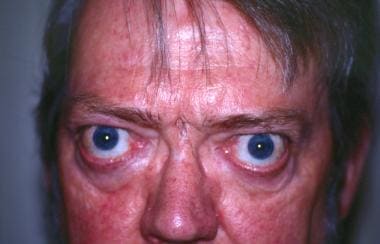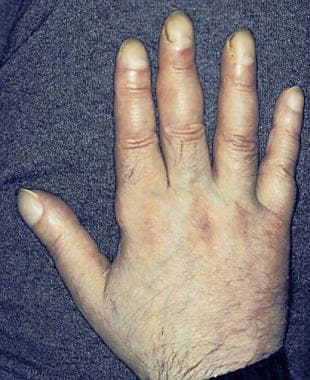Overview
Thyroid-associated orbitopathy (TAO), frequently termed Graves ophthalmopathy, is part of an autoimmune process that can affect the orbital and periorbital tissue, the thyroid gland, and, rarely, the pretibial skin or digits (thyroid acropachy).
This condition is the most common autoimmune disease of the orbit.
Although the use of the term thyroid ophthalmopathy is pervasive, the disease process is actually an orbitopathy in which the orbital and periocular soft tissues are primarily affected with secondary effects on the eye. See the images below.
Long-standing thyroid-associated orbitopathy with typical features of lid retraction (upper and lower) and scleral show with proptosis. This patient’s chief complaint was binocular vertical diplopia. A small right hypotropia was observed on alternate cover testing.
Thyroid acropachy imitates the appearance of clubbing and is an uncommon finding in patients with thyroid-associated orbitopathy. This patient required bilateral orbital decompression and strabismus surgery.
Thyroid-associated orbitopathy is usually self-limiting and associated with Graves disease. In a minority of cases, this condition complicates Hashimoto thyroiditis. Cases have also been reported in hypothyroidism.
A retrospective, cross-sectional study of 461 German patients with thyroid-associated orbitopathy found a 4.3% prevalence of euthyroid/hypothyroid and a 95.7% prevalence of hyperthyroid.
Thyroid-associated orbitopathy may precede, coincide, or follow the systemic complications of dysthyroidism. Risk factors for thyroid-associated orbitopathy include increased age of onset, duration of Graves hyperthyroidism, and smoking.
The ocular manifestations of thyroid-associated orbitopathy include eyelid retraction, proptosis, chemosis, periorbital edema, and altered ocular motility with significant functional, social, and cosmetic consequences. Of affected patients, 20% indicate the ocular morbidity of this condition is more troublesome than the systemic complications of dysthyroidism.
The annual incidence rate of thyroid-associated orbitopathy has been estimated at 16 cases per 100,000 women and 2.9 cases per 100,000 men in one rural Minnesota community.
There appears to be a female preponderance, with women are affected 2-6 times more frequently than men; however, severe cases occur more often in men than in women.
In addition, most patients are aged 30-50 years, with severe cases appearing to be more frequent in those older than 50 years.
Early diagnosis and appropriate monitoring of thyroid-associated orbitopathy may decrease corneal exposure and compressive optic neuropathy. Although most cases of thyroid-associated orbitopathy do not result in visual loss, this condition can cause vision-threatening exposure keratopathy, troublesome diplopia, and compressive optic neuropathy. Therefore, although the prognosis is generally favorable for patients with this condition, and most patients do not require surgical intervention,
all clinicians should be able to recognize thyroid-associated orbitopathy.
See also the following:


